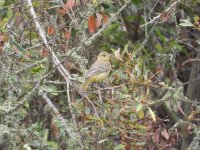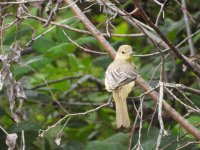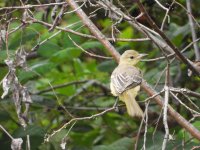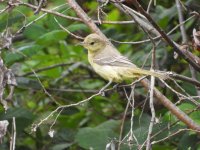A Terrible Human Being
Member

I led a Stanislaus Audubon field trip to Monterey County today, our first stop was Laguna Grande Park in Seaside. We walked along the creek, from the lake toward Fremont Blvd. When we got to the end of the trail it was extremely birdy! We found this oriole there. I thought it looked very small, there were a few House Finches just behind it and it did not look very much larger than they did. I have only ever seen two Orchard Orioles in my life and both of them were males, one in full alternate plumage (50' up in a Paulownia Tree, in Merced County), and one molting into alternate (in San Francisco, it was at eye-level, but it was very flighty and I never got a good look at the bill), and I have never seen a female Orchard. Based on my impression of size, I am thinking that this might be a female Orchard Oriole, but I cannot rule out Hooded based on my limited knowledge of Orchard. Does anyone have an opinion on this bird, perhaps someone who has a good deal of experience with Orchard Oriole?
Thanks in advance for any help,
A Terrible Human Being (AKA Ralph)
Thanks in advance for any help,
A Terrible Human Being (AKA Ralph)







